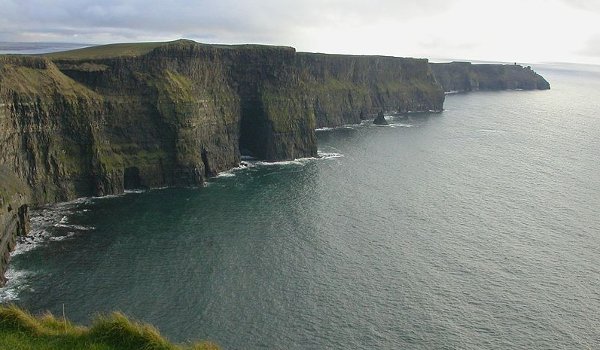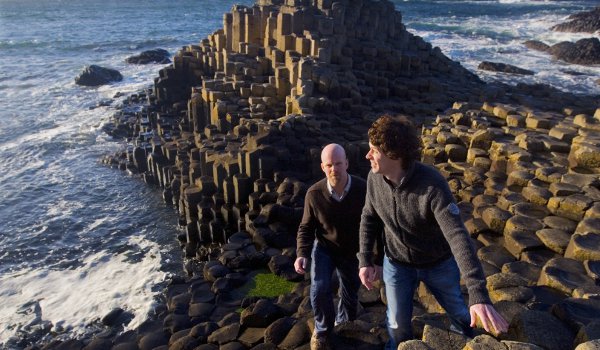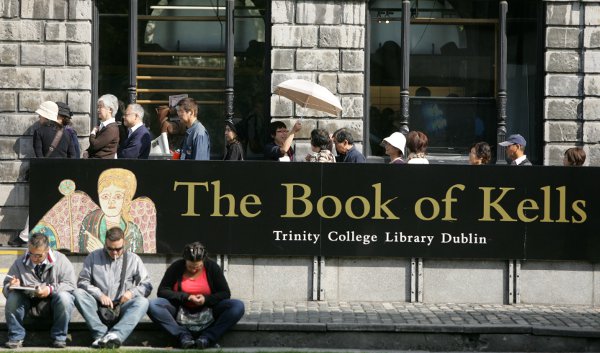SMARTER Travel website has come up with the 10 most disappointing travel destinations in the world – and Dublin’s Temple Bar was top of the list, with the website saying that the area is a prime example of the rampant fleecing of drunken tourists that should be avoided at all costs.
This week we decided to look at some of Ireland’s other must-see sights to see if they really are just that.
In assaying the ‘Disappointment quotient’ we’ve used a traveller’s version of the Deadweight Loss of Christmas Presents.
In this festive survey you estimate how much a present you’ve been given has cost; you then judge what you’d have paid to own the gift (you might not have wanted it at all, so would have paid nothing) – the difference between the two estimates is the deadweight performance. So now, on with the tour!
Cliffs of Moher, Clare
The Cliffs of Moher are where the Old World comes to a dramatic and sudden end. Westwards from here three thousand miles of angry ocean separate you from the Americas.
The cliffs are everything you might expect from one of Ireland’s top tourist destinations – huge towering rocky edifices, plumes of spray from the Atlantic jacuzzi and thousands of seabirds.
The visitors’ centre is about as good as you’re likely to get. You’re probably wondering why somewhere as spellbinding as this westerly wonder needs an interpretive centre and many before you – including a large percentage of the locals – would agree with you.
 Cliffs of Moher, Clare
Cliffs of Moher, ClareThe grass-domed (yes, grass not glass) subterranean building is about as unobtrusive as you can get. Set in a re-ordered landscape of Liscannor-flagged pathways, stone walls and elevated viewing platforms, it does its interpreting job reasonably well.
But there are no two ways about it – whether from the visitors’ centre or the clifftop pathway, this is one of Europe’s top views.
However, like many of Ireland’s most popular sights, your time of arrival at the cliffs may have a bearing on your enjoyment, and on the disappointment deadweight quotient.
Walk along the cliff top in the company of 150 teenage tourists from a school in Spain, and you’ll possibly miss out on the more spiritual side of the experience. However, go early in the morning or late in the evening, avoid peak months, and the experience is likely to be unforgettable.
One other alternative is to take the boat from Liscannor or Doolin. I’d agree with those who believe this is the finest way to see the cliffs – the rocky stacks that protrude out of the sea spray are a wondrous sight as you round a promontory and the cliffs proper heave into view.
Disappointment deadweight quotient: On busy days in peak tourist season, you can expect a DDQ of up to 40 per cent. Choose the right day, the right time, or go by boat – and it’ll be zero.
 The astonishing natural phenomenon that is The Giant's Causeway, Antrim
The astonishing natural phenomenon that is The Giant's Causeway, AntrimGiant’s Causeway, Antrim
The Causeway Coastal Route, aka the Antrim Coast Road is reckoned today to be one of the most spectacular routes in the world, regularly up there in the same company as the San Bernardino Pass in the Alps or the Monterey-Carmel coast road in California.
It passes by some top grade sights such as Dunluce Castle (which looks as if it has tumbled out of a fairytale, and is about to tumble into the ocean, so precariously is it perched on rocks); Ballintoy Harbour – so dramatic that it appears in HBO’s Game of Thrones – and bays and inlets, glens and beaches that support several postcard industries.
And the road leads past the Giant’s Causeway. For centuries this geological wonder was known only to kelp gatherers, shepherd and fishermen. The 40,000 columns of basalt are today one of Ireland’s three UNESCO World Heritage Sites.
From the shop at the top of the cliff you can get a tourist bus down to the columns – with names like the Giant’s Granny, the King and the Nobles, and the Chimney Pots.
But the presence of the tourist bus gives a clue to the downside that the Giant’s Causeway suffers from. Just like the Cliffs of Moher, the Giant’s Causeway is a magnet for tourists. So, with the same provisos about visiting times, we can confirm – the Giant’s Causeway certainly does deliver.
This astonishing stony complex of octagonal basalt columns packed together borders an inlet of the sea where eider ducks patrol ceaselessly and seals pop their heads up, curious about all the activity. You are unlikely to be disappointed, so the Giant’s Causeway once again gets the much sought after zero DDQ.
 The English Market, Cork
The English Market, CorkThe English Market, Cork
Recently given much prominence owing to an old lady from London SW1 visiting in 2011, is the English Market in Cork. From Grand Parade you can dive straight into the market (as per Queen Elizabeth), and you’ll be confronted by a vast covered concourse packed with literally hundreds of stalls.
Local specialties such as Clonakilty pudding and tripe are available, as well as fresh organic vegetables, cheeses and all manner of bakery.
There has been a market here since 1788, but the current Victorian buildings date back to the 90th century – the building itself is part of the market’s charm.
It would be fair to say that the English Market could feature in a vegetarian’s worst nightmare; also, some of the produce you might just as easily pick up in any shop, possibly cheaper.
For those reasons we’re going to mark the English Market down slightly. It’s still worth a visit, but bear in mind it could have a deadweight disappointment quotient of as much as 20 per cent, depending on personal taste.
The Gap of Dunloe, Kerry
The Gap of Dunloe provides, quite simply, one of the world’s finest panoramas. This narrow eight mile pass through Ireland’s highest mountains, MacGillycuddy’s Reeks, begins at Kate Kearney’s Cottage and finishes with a descent into the Black Valley.
En route it passes loughs and streams, mountains and woodland, and stone monuments and statues worn by millennia of moody weather. If you’re lucky you’ll pass one of Ireland’s oldest red deer herds.
The best way to experience this amazing road is to park the car, and journey through the Gap on the Kerry Way by foot. That way you’ll miss the tour buses.
The Gap of Dunloe, being in a mountainous area and on the westerly fringes of Ireland, can be very wet. Drop your wooden walking stick here and it’ll probably take root. There are ferns here which grow on the branches of trees. Now, that’s damp.
The other downside is, as ever, the tour buses, and the rampant commercialism and paddywhackeray of some of the pubs, cafes, restaurants and hotels along the way and in the surrounding hinterland. For those reasons I’m going to have to mark down the Gap of Dunloe some five per cent. You’ll probably enjoy it, but you might be disappointed.
 The Book of Kells, Dublin
The Book of Kells, DublinThe Book of Kells, Dublin
This priceless illuminated manuscript is housed in the Long Room of Trinity College, Dublin. This is as spiritually far removed from Temple Bar as it’s possible to get.
Amongst the few dozen most valuable books in the world, the 9th century Book of Kells consists of the first four Gospels of the New Testament, portrayed with exquisite artistry using Celtic, Anglo-Saxon and Germanic ornamentation.
The book was probably the work of monks on the island of Iona – because of the ‘fingerprints’ of the exquisite art, four scribes are generally assumed to have been engaged on the project. The book subsequently found refuge in Kells in Co. Meath, although details of its journey or itinerary are unknown.
You’ll have to queue to see the book, and you can’t leaf through it, as you enjoy a cup of tea. The book is housed in a glass cabinet, and only one page is shown at a time.
Nonetheless, to get to the Library, you’ll have a memorable walk through the cobbled stones of Trinity College Dublin to the magnificent 18th century Old Library building. The Long Room is lined with 200,000 of the Library’s oldest books in its oak bookcases; but before you ask, no, you can’t borrow any of them.
The Book of Kells was voted the No. 2 top attraction in Ireland to visit on TripAdvisor’s list of Ireland’s Top 10 Attractions for 2013 – so how does it measure up on our DDQ metre? Very well indeed, up there with the Cliffs of Moher and the Giant’s Causeway in delivering zero disappointment. Well done those monks!
 Newgrange burial chamber, Meath
Newgrange burial chamber, MeathNewgrange or Brú na Bóinne, Meath
Every December 21, or the Winter Solstice, there is a moment of magic in Co. Meath – as there has been for the last 5,000 years. A pencil of dawn sunlight penetrates the Neolithic burial chamber at Brú na Bóinne, a huge structure built by our early forebears.
The building is perfectly aligned so that the first rays of the solstice sun pierce through a small opening in the chamber’s roof and travel nineteen metres along a narrow stone passage to focus on the entrance to the grave. The chamber is bathed in daylight for some 17 minutes, before darkness returns.
Sadly, demand is so high to experience this event that an annual lottery is held (contact through www.newgrange.com) and visitors come from across the world. Last year 29,503 people applied for 50 places – if you’re one of the lucky ones, you can bring a guest.
The “show” lasts for three days on either side of the solstice, although you can see glimmers of the phenomenon at other times of the year.
Aside from the light show, you can visit the various chambers, and structures which are older than both Stonehenge and the Pyramids. Described as one of the most important megalithic structures in Europe, naturally it has very little in the way of dissatisfaction baggage.
We are pleased to say that you’re extremely unlikely to be disappointed with this incredible structure, and so it is awarded – as well as its UNESCO World Heritage Site status – a disappointment deadweight quotient of zero.


